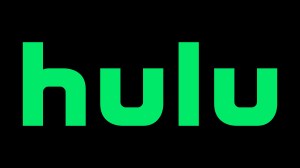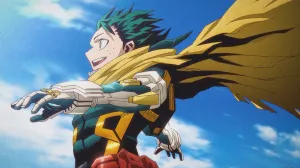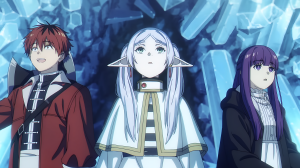
Tomorrow, writer Shea Fontana and artist Yancey Labat will unveil the first part of their original graphic novel DC Super Hero Girls: Finals Crisis, coming in July and set in the world of the world of the popular animated series and merchandising line.
Videos by ComicBook.com
That’s in the form of DC’s Free Comic Book Day release, the first chapter of the book and a handful of character bios bound into Free Comic Book Day: DC Super Hero Girls.
In Super Hero Girls, characters from the comics are thrown together at Super Hero High School, where they play very different roles from the dark and usually adversarial ones they have in the “main” line of DC Comics, the movies, or the like.
Fontana joined ComicBook.com to talk about the release, the graphic novel, and the challenges of retaining the core of iconic characters while reinventing them for the new format.
There’s a lot of characters and you’re speaking to a largely uninitiated audience. What is the hardest part of putting something like that together in a way that you know, there’s going to be a million of these in print.
I think the big thing for us, the Free Comic Book Day issue is actually the first two chapters of the graphic novel, Finals Crisis, that’s going to be coming out in June … July, sorry. I think the big thing for us as the first graphic novel and the first chapters is always establishing where we are and establishing our characters. You’re right, there are a ton of characters, so it’s really about finding the ways because we are in a high school environment, and finding those touchstones that kids can relate to, like it is in the Finals Crisis. It’s all about the night before finals and every kid knows what that’s like.
It’s finding these ways to introduce all our our characters and the setting Super Hero High, within that context and really getting into the story very quickly because you only have so many pages in a comic book and so many panels and it all goes by really, really fast. We have to strive to make sure we’re clear about our characters an clear about this world and making sure that everything is reading properly to someone who is like our audience is: 6-, 7-, 8-year-old girls who probably haven’t read a lot of comic books before. It’s not only about establishing a world, but getting them into this genre of reading comic books. There’s definitely, that’s something that we thought about as we were going into it, making sure that everything is really concise and clear.
Do you have defacto point of view character, or does the book try to give everybody a relatively equal amount of “screen time”?
The way the graphic novel is set up, we have a chapter from the point of view of each our our main 7 characters: Batgirl, Wonder Woman, Supergirl, Kitana, Bumblebee, Poison Ivy and Harley. We all see one chapter from their point of view, so it’s all happening at the same time or during the same time period.
We see what they’re doing or how they’re preparing for the finals as well as how they’re going to be interacting with this mysterious super villain that’s after them that night. It’s really fun to get into each of the characters’ heads and see the differences. They’re all superheroes, they’re all at Super Hero High, but everybody is going to take on this task very differently depending on what their powers are and what their personalities are.
When you’re doing something like this, obviously you have characters like Wonder Woman whose mainstream comic book origin is that she is 4,000 years old or something, and Harley, who is evil. How do you put them into the sort of environment that you need for Super Hero High and still retain the essence of what makes them, them?
We are definitely in a different universe than the canon universe. All of the characters are 16 or however old high school kids are. They are within the high school range and they do have the same kind of powers that they have in the canon world. We think of it as, they have the same DNA but they have different life experiences and they’re going about their Super High experience in different ways.
We know that, in the canon world, Poison Ivy doesn’t get her powers until later on in life, but she’s in high school here and she has her powers. We definitely have changed that story, but we really want to maintain the essence of the characters and make sure that their base personalities come through while maintaining that … What happens to us in life does, obviously, make us different.
So someone like Harley, she doesn’t have all those experiences that led her to be a villain. Now she has a really supportive group of friends at High School and how does that change her? How does that make her a better person? Instead of choosing to be a villain, she’s choosing to be a hero.
One of the things I talked with the Tiny Titans guys, about back in the day, was the challenges of writing superhero stories in an environment where you’re writing them for kids and you don’t really want them to be super violent. You don’t want the fight scenes to be all that brutal. How do you make something like a super villain coming in and needing to be beaten visually compelling when, in the back of your head, you’re sitting there going, “I really don’t want this to be violent.”
You know, I would say we don’t shy away from action. It’s very much about the heroes using their powers and being able to really show off their super strengths or their ability to shoot lasers from their eyes or whatever, whatever their specific powers are. We’re certainly not violent, but we…punches are thrown.
We’re very careful about making it appropriate for this level of audience, for girls 6 to 12, but we are embracing the action side of superheroes as well. We want to make sure that they are using their powers in clever ways to defeat the enemy, and sometimes that is to use brute strength.
One of the things that strikes me about this project is it’s coming, first of all, at the same time as Supergirl. Secondly, there’s this larger cultural discussion about female action heroes. Are you sometimes baffled by the backlash for projects like this?
It’s totally baffling when there are people who don’t want that. I don’t know how to respond to those people because there is obviously something very deeply ingrained into their value system. We are trying to inspire young girls and show them that they can be the heroes of their own story and they can have a prominent place within the superhero mythologies. We think that we’re doing something good.
Do you think it’s also helpful to be pitching to young girls at a time when there’s the PG-13 content on TV, in the movies, and on toy shelves for them to grow into and compare and contrast against? Certainly for older kids, or boys, or whoever, you’ve got Batman V Superman literally on the next endcap at Target.
Absolutely. We think that it’s not just for girls. It’s for everyone. Whether you’re a boy or a girl, you can appreciate good storytelling and fun animation and all those great things. I think there is a lot of crossover. I’ve seen a lot of people have sent me tweets of boys playing with the action figures and with their action figures. It’s been really fun to see things like that, and I think our action figures fit in just fine with Batman and Superman and everyone else.
I think we’ve really played up that it’s a world where girls and boys exists and it’s inclusive and it’s diverse. We want everybody, not just girls but boys to, to be able to see themselves represented and realize that superheroes are for everyone. It’s not just for boys and it’s not just for girls, but it’s a world where we can all get along.








